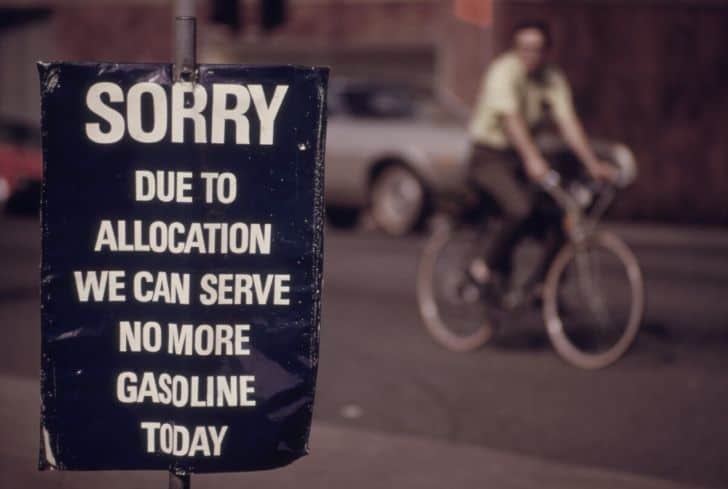The energy crisis stems from the increasing global demand for limited natural resources, essential for powering our industrial society. As the demand for these resources increases, they edge closer to depletion, presenting a pressing concern.
Sure, these resources occur naturally, but replenishing them can take hundreds or thousands of years, making them scarce commodities.
Governments and concerned individuals are working together to prioritize the use of renewable resources and lessen the irresponsible use of natural supplies through increased conservation.
The energy crisis is a broad and complex topic. But most people don’t feel connected to its reality until they experience increased fuel prices and longer lines at the pump.
According to Wikipedia,
“An energy crisis is any significant bottleneck in the supply of energy resources to an economy. In literature, it often refers to one of the energy sources used at a certain time and place, in particular those that supply national electricity grids or those used as fuel in Industrial development and population growth have led to a surge in the global demand for energy in recent years.””
How Real is the Energy Crisis?
During election years, there is a renewed debate on how “real” the energy crisis is in the world.
One side will always say it is based on faulty science and politics; the other will say that the opposite side is basing its findings on junk science and political interests.
The best way to sum up the reality of the energy crisis is that you cannot have growing demands on limited resources without eventually running out of the resource.
That is just common sense.
Essentially, whether or not the energy crisis is real depends on our perception of responsibility for the future.
If we disregard everything that happens after our time on Earth is up, then the energy crisis may not seem real. But if we can view the situation from far and wide perspective with interest in future generations, then it’s easy to see the reality of the energy crisis.
Various Causes of the Global Energy Crisis
It would be easy to point the finger at one practice or industry and lay the blame for the entire energy crisis at their door, but that would be a very naive and unrealistic interpretation of the cause of the crisis.
1. Overconsumption
The energy crisis results from many different strains on our natural resources, not just one. There is a strain on fossil fuels such as oil, gas, and coal due to overconsumption – which then, in turn, can put a strain on our water and oxygen resources by causing pollution.
2. Overpopulation

Another cause of the crisis has been a steady increase in the world’s population and its demands for fuel and products. No matter what type of food or products you choose to use – from fair trade and organic to those made from petroleum products in a sweatshop – not one is made or transported without a significant drain on our energy resources.
3. Poor Infrastructure
The aging infrastructure of power-generating equipment is yet another reason for energy shortage. Most of the energy-producing firms keep on using outdated equipment that restricts the production of energy. It is the responsibility of utilities to keep upgrading the infrastructure and set a high-performance standard.
4. Unexplored Renewable Energy Options
In many countries, renewable energy sources remain largely untapped, while non-renewable sources like coal dominate the energy production landscape. As a result, coal remains the preferred choice for meeting energy demands.
Unless we give renewable energy serious thought, the energy crisis cannot be solved. That’s because renewable energy sources can reduce our dependence on fossil fuels and also helps to reduce greenhouse gas emissions.
5. Delay in Commissioning of Power Plants
In a few countries, there is a significant delay in the commissioning of new power plants that can fill the gap between demand and supply of energy. The result is that old plants come under immense stress to meet the daily demand for power. When supply doesn’t match demand, it results in load-shedding and breakdown.
6. Wastage of Energy
In most parts of the world, people do not realize the importance of conserving energy. It is only limited to books, the internet, newspaper ads, lip service, and seminars. Unless we begin implementing what we already know about energy conservation in our everyday life, the energy crisis can only worsen with time.
Simple things like switching off fans and lights when not in use, using maximum daylight, walking instead of driving for short distances, using CFL instead of traditional bulbs, and proper insulation to minimize energy leakage can go a long way in saving energy. Read here about 151 ways of saving energy.
7. Poor Distribution System
Frequent tripping and breakdown are a result of a poor distribution system.
8. Major Accidents and Natural Calamities
Major accidents like pipeline bursts and natural calamities like the eruption of volcanoes, floods, and earthquakes can also cause interruptions to energy supplies.
9. Wars and Attacks
Wars between countries can also hamper the supply of energy, especially if it happens in Middle East countries like Saudi Arabia, Iraq, Iran, Kuwait, UAE, or Qatar.
That’s what happened during the 1990 Gulf War when the price of oil reached its peak, causing global shortages and creating major problems for energy consumers.
10. Miscellaneous Factors
Tax hikes, strikes, military coups, political events, severe hot summers or cold winters can cause a sudden increase in energy demand and choke supply. A strike by trade unions in an oil-producing firm can cause an energy crisis.
Various Effects of the Global Energy Crisis
The growth of human civilization has led to increased consumption of traditional energy sources, particularly fossil fuels. This extensive usage inevitably leads to several significant effects related to the global energy crisis, including:
1. Environmental Effects
Energy is produced by burning non-renewable fossil fuels. This does not only affect the global resources of fossil fuels but also the environment.
You see, burning fossil fuels releases greenhouse gases like carbon dioxide. These gases create a blanket on the earth’s surface, preventing the release of the short rays of the sun by night.
Thus, we can safely argue that the energy crisis facilitates making the earth a warmer place by promoting global warming.
2. Increasing Prices of the Fuel Resources
The escalating use of fossil fuels drives an increase in their cost, given their limited availability. As consumption continues, the quantity of these precious resources declines, heightening concerns about their future scarcity.
As each day passes, fossil fuel demand increases while availability decreases. This leads to a gradual and persistent increase in price, creating a huge economic disturbance across the globe.
3. Political Disturbances
The fact that the energy crisis creates some socio-economic disturbances also tells us that it also creates a lot of political disturbances across the globe. In fact, the quest for fossil fuels is one of the major causes of the same.
Besides, with the failure of the energy markets, we see a crash in not only the global economy but also in the energy available. All these are enough to cause socio-political disturbances.
4. The Effect on the Tourism Industry
The tourism industry is largely dependent on the rise and fall of fuel prices. The tremendous rise in fuel prices from the energy crisis affects the tourism industry pretty adversely.

That’s because the increase in fuel prices also means an upsurge in the costs of tourism, leaving only a few able to afford it. This decline in the number of tourists translates to lower revenue generated through tourism industry.
Possible Solutions to the Problem of Global Energy Crisis
Many of the possible solutions are already in place today, but they have not been widely adopted.
1. Move Towards Renewable Resources
The best possible solution is to reduce the world’s dependence on non-renewable resources and to improve overall conservation efforts.
Much of the industrial age heavily relied on fossil fuels, but there are established technologies that leverage renewable energy sources, such as steam, solar, and wind.
In switching to renewable energy sources, we must understand that the primary concern lies not in depleting gas or oil reserves but in the continued use of coal, which pollutes the atmosphere and destroys other natural resources during mining. That will help us understand why the shift is necessary even with access to fossil fuels.
2. Buy Energy-Efficient Products
Replace traditional bulbs with CFLs and LEDs. They use fewer watts of electricity and last longer. If millions of people across the globe use LEDs and CFLs for residential and commercial lighting, the demand for energy can decrease, and an energy crisis can be averted.
3. Lighting Controls
The other step we can take to save the global energy crisis is switching to lighting controls. Lighting controls aren’t just interesting technologies; they’re also a great way to cut on the energy you use, consequently reducing your energy bills.

Preset lighting controls, slide lighting, touch dimmers, and integrated lighting controls are a few of the lighting controls that can help to conserve energy and reduce overall lighting costs.
4. Easier Grid Access
People who use different options to generate power should be given a way to plug into the grid and get credit for the excess amount of power they feed into it. Apart from that, subsidies on solar panels should be given to encourage more people to explore renewable options.
5. Energy Simulation
Big corporates and corporations can use energy simulation software to optimize their building units and reduce energy costs.
By utilizing such software, engineers, architects, and designers can create highly energy-efficient buildings, effectively reducing the carbon footprint of these structures.
6. Perform Energy Audit
The energy audit is a process that helps you to identify the areas where your home or office is losing energy and what steps you can take to improve energy efficiency.
When done by a professional, an energy audit can help reduce your carbon footprint, save energy and money, and relieve the current energy crisis.
7. Common Stand on Climate Change
Both developed and developing countries should adopt a common stand on climate change. They should focus on reducing greenhouse gas emissions through an effective cross-border mechanism.
With current population growth and overconsumption of resources, the consequences of global warming and climate change cannot be ruled out. Both developed and developing countries must focus on halving their emissions by 2050.
What is Being Done Today?
There are many global initiatives that are working towards resolving the energy crisis. These include stricter regulations and restrictions on carbon emissions, the promotion of greener manufacturing and construction projects, the funding of research into hybrid and other sustainable technologies, and more.
Locally, the communities are becoming more informed on the importance of using resources responsibly, extending beyond just recycling.
More community gardens, parks, and farmer’s markets are springing up not only as a means of introducing more sustainable elements into people’s lives but as an essential part of educating the public about the importance of resources.
References:







